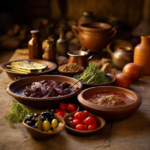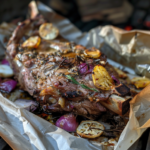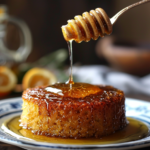Join us on a flavorful journey as we navigate through the delightful world of Best of Greek cheeses.
From the tangy and crumbly feta to the creamy and buttery halloumi, Greek cheeses offer a wide range of tastes and textures that are sure to delight your senses. Get ready to explore the centuries-old traditions and unique techniques that make Greek cheeses a true culinary treasure. Whether you’re a cheese connoisseur or simply a lover of all things delicious, this article will open your eyes to the wonders of Greek cheese and leave you craving for more. So, grab your favorite wine or a glass of ouzo, and let’s embark on this delectable adventure together.

Types of Greek Cheeses
Greek cuisine is renowned for its flavorful and diverse variety of cheeses. From the creamy and tangy feta to the versatile grilling cheese halloumi, there is a Greek cheese to suit every palate. Let’s take a closer look at some of the most popular Greek cheeses and explore their distinct characteristics and uses.
Feta
Feta, perhaps the most well-known Greek cheese, is a staple in Greek cuisine. This crumbly, salty cheese is made from a combination of sheep’s and goat’s milk, which gives it a unique flavor and texture. Feta has a rich and tangy taste, with a creamy mouthfeel that makes it a perfect addition to salads, sandwiches, and pastries. Whether enjoyed on its own or incorporated into various dishes, feta is a versatile cheese that adds a delightful Mediterranean touch to any meal.
Halloumi is a Greek grilling cheese that has gained popularity worldwide for its unique qualities. This semi-hard cheese has a firm texture and high melting point, which allows it to be grilled or fried without losing its shape. Halloumi has a mild, slightly salty taste with a hint of tanginess. Its versatility in the kitchen is unparalleled, as it can be used in salads, sandwiches, or even as a vegetarian alternative to meat, thanks to its satisfying chewiness when cooked. Whether pan-fried, grilled, or added to a BBQ skewer, halloumi is a delicious addition to any meal.
Kefalotyri
Kefalotyri is a hard, salty cheese often used in Greek cuisine for its distinct flavor and grating properties. Traditionally made from sheep’s or goat’s milk, kefalotyri has a nutty and tangy taste that intensifies with age. This cheese is commonly used in traditional Greek dishes such as saganaki, a fried cheese appetizer, and avgolemono soup, a creamy and lemony chicken soup thickened with eggs. The robust flavor and crumbly texture of kefalotyri make it a fantastic addition to pasta dishes or as a topping for grilled vegetables.
Kasseri is a semi-hard cheese with a creamy and tangy flavor that is often compared to a combination of cheddar and mozzarella. Made from sheep’s or goat’s milk, kasseri cheese has a unique stretchy quality when melted, making it a popular choice for Greek-inspired pizzas and savory pies. The cheese-making process involves heating and stretching the curds, resulting in a smooth and elastic texture that is perfect for grilling or frying. Kasseri can also be enjoyed on its own, paired with fruits or nuts for a delightful combination of flavors.
Manouri is a velvety and creamy cheese that is often referred to as a cousin of feta. Made from the whey leftover from the feta-making process, manouri has a delicate yet rich taste with a smooth, almost custard-like texture. This cheese is mild and slightly sweet, making it a versatile ingredient in both savory and sweet dishes. Manouri can be used as a filling for pastries, added to salads or pasta dishes, or even enjoyed with honey and nuts as a dessert. Its delicate and luxurious flavor makes it a favorite among connoisseurs of Greek cuisine.
The History and Tradition of Greek Cheeses
Ancient Origins
Cheese-making has a long and storied history in Greece, dating back thousands of years to ancient times. The ancient Greeks valued cheese for its nutritional properties and considered it to be a symbol of abundance and prosperity. Artifacts and writings from the time have provided valuable insights into the cheese-making techniques used by the Greeks, showcasing their deep knowledge and understanding of the craft. The production and consumption of cheese were integral parts of their culture, and the tradition has been passed down through generations, evolving into the rich cheese heritage that Greece enjoys today.

Cheese-Making Techniques
The ancient Greeks employed various techniques to make cheese, many of which are still used today. The most common method involved curdling milk using rennet or sour milk, separating the curds from the whey, and then pressing and aging the curds to transform them into cheese. Different regions in Greece developed their own unique methods and variations, utilizing different types of milk, tools, and storage techniques. The result is a wide array of Greek cheeses, each with its unique flavors and characteristics.
Cultural Significance
Greek cheeses hold great cultural significance in Greek society. They are not merely ingredients in dishes; they are an expression of Greek identity and tradition. Cheese-making is often a communal activity, with families and communities coming together to produce and share their cheeses. Festivals and celebrations dedicated to cheese are common throughout Greece, showcasing the pride and passion that the Greeks have for their cheese. From the sacred rituals of ancient times to the modern-day celebrations, Greek cheeses are deeply ingrained in the fabric of Greek culture.
Feta: The World-Famous Greek Cheese
Origin and Authenticity
Feta cheese has a long and storied history that dates back centuries. Its origins can be traced to Ancient Greece, where it was believed to have been a staple in the diet of Spartan warriors. Today, feta is protected by EU legislation, ensuring that only cheeses made in specific regions of Greece and following strict production methods can be labeled as “feta.” This designation ensures the authenticity and quality of feta, offering consumers the assurance that they are enjoying a genuine Greek product.
Production Process
The production of feta is a carefully controlled process that follows traditional methods passed down through generations. Feta is m
ade from a combination of sheep’s and goat’s milk, which contributes to its distinct flavor profile. The milk is curdled using rennet or microbial agents, and the resulting curds are cut and transferred to molds to drain excess whey. After two to three days, the curds are salted and stored in brine for several weeks, allowing the cheese to develop its characteristic tangy flavor. The aging process varies depending on the desired taste and texture, with feta ranging from soft and crumbly to firm and sliceable.

Uses in Greek Cuisine
In Greek cuisine, feta is an essential ingredient that adds a burst of flavor to a wide range of dishes. From traditional Greek salads to spanakopita (spinach pie) and tiropita (cheese pie), feta brings a unique Mediterranean touch to every bite. Its crumbly texture and salty taste make it a fantastic addition to baked dishes, pasta salads, and even grilled meats. Feta is also delicious when paired with fruits or drizzled with honey for a sweet and savory combination. Its versatility and distinctive flavor have made feta one of the most beloved Greek cheeses around the world.
Halloumi: The Versatile Grilling Cheese
Origins and Cultural Significance
Halloumi cheese has its origins in Cyprus, an island with a rich cheese-making tradition that influenced Greek cuisine. Although not exclusively a Greek cheese, halloumi has become a popular ingredient in Greek cuisine, thanks to its unique properties. In Cyprus, halloumi cheese holds great cultural significance and is often enjoyed during festivals and special occasions. The grilling of halloumi has also become a beloved culinary tradition, with families and friends gathering around barbecues to enjoy the sizzling cheese.
Distinct Qualities
Halloumi stands out from other cheeses due to its high melting point and distinctive texture. Made from a blend of sheep’s and goat’s milk, halloumi has a firm and rubbery texture that becomes soft and gooey when heated. This unique quality allows halloumi to be grilled, fried, or pan-fried without losing its shape, making it a popular choice for vegetarian BBQs and meat alternatives. Halloumi has a mild and slightly tangy flavor, which pairs well with a variety of ingredients and spices. Its versatility in both sweet and savory dishes makes halloumi a favorite among chefs and food enthusiasts worldwide.
Cooking and Serving Suggestions
Halloumi’s versatility extends to the countless ways it can be prepared and served. Grilled halloumi is a beloved dish, often enjoyed as a standalone appetizer or as part of a larger meal. The heat from the grill caramelizes the surface of the cheese, creating a golden and slightly crispy exterior while leaving the interior soft and gooey. Grilled halloumi can be served with a drizzle of olive oil and a squeeze of lemon juice, or paired with fresh herbs and vegetables for a vibrant salad. It can also be incorporated into wraps, sandwiches, or even desserts, adding a unique savory element to the dish.
Kefalotyri: From Soup to Saganaki
About Kefalotyri
Kefalotyri is a hard cheese with a slightly yellowish color and a salty, tangy taste. This cheese has a long history in Greece, with references to its production dating back centuries. Traditionally made from a combination of sheep and goat milk, kefalotyri is known for its robust flavor and grating properties. Its firm texture makes it ideal for grating and melting, allowing it to be used in a wide range of dishes.
Traditional Uses
Kefalotyri is a staple in Greek cuisine and is often used in traditional dishes such as saganaki, a popular Greek appetizer. Saganaki involves frying the cheese until it becomes golden and slightly melted, creating a deliciously gooey texture with a slightly crispy exterior. This dish is typically served with a squeeze of lemon, adding a refreshing zest that complements the richness of the cheese. Kefalotyri is also commonly used as a topping for pasta dishes, baked vegetables, or even as a standalone appetizer paired with fruits or nuts.
Modern Applications
Although kefalotyri is traditionally used in Greek cuisine, it has found its way into modern applications, thanks to its distinctive flavor and versatile nature. This cheese is a fantastic addition to gratins, adding a layer of richness and depth to the dish. Grated kefalotyri can also be sprinkled over soups or stews, melting into the hot liquid to create a creamy and savory broth. Its tangy and salty taste balances well with other ingredients, making it a favorite among chefs looking to add a burst of flavor to their creations.
Kasseri: A Unique Combination of Creaminess and Tang
Introduction to Kasseri
Kasseri is a semi-hard cheese that hails from the regions of Thessaly and Macedonia in Greece. This cheese is widely known for its unique combination of creaminess and tanginess, which sets it apart from other Greek cheeses. Made from sheep’s or goat’s milk, kasseri has a smooth and elastic texture that makes it suitable for melting and grilling. Its distinct flavor is often compared to a combination of cheddar and mozzarella, with a slight tangy twist.
Cheese-Making Process
The cheese-making process for kasseri involves heating and stretching the curds, which gives it its characteristic stretchy texture. After curdling the milk using rennet or sour milk, the curds are cut and boiled in a large cauldron until they reach a specific temperature. Once the desired temperature is reached, the curds are hand-stretched, creating long strands of cheese. The cheese is then formed into large wheels or smaller blocks and aged for several months, allowing it to develop its distinct flavor and texture.

Recipes and Pairings
Kasseri’s unique qualities make it a versatile cheese that can be used in a variety of recipes. When melted, kasseri becomes gooey and slightly stringy, making it an excellent choice for grilled cheese sandwiches, quesadillas, and pizzas. Its creamy texture and tangy flavor pair well with a variety of ingredients, such as roasted vegetables, cured meats, or even sweet fruits like figs or grapes. Kasseri can also be enjoyed on its own, served with crackers or bread, allowing the flavors of the cheese to shine.
Manouri: The Delicate and Creamy Cheese
Characteristics of Manouri
Manouri is a soft and creamy cheese that is often referred to as a cousin of feta. Made from the whey left over from feta production, manouri has a delicate and slightly sweet taste, with a smooth and velvety texture. This cheese is known for its luxurious mouthfeel and the way it melts in the mouth, leaving a subtle and lingering flavor. Manouri has a milky and nutty taste, making it a versatile ingredient in both savory and sweet dishes.
Making Manouri
The production of manouri involves collecting the whey left over from the feta-making process and heating it to separate the remaining milk proteins. The separated proteins are then drained and pressed, removing excess liquids and creating a soft and creamy cheese. Manouri does not undergo an aging process, making it the perfect cheese for immediate consumption. Its soft and delicate texture, along with its mild yet flavorful taste, have made manouri a favorite among cheese lovers.
Popular Dishes
Manouri’s versatility allows it to shine in a variety of dishes. In savory recipes, manouri can be used as a filling for pastries or as a topping for salads, adding a rich and creamy element. Its mild taste allows it to complement a wide range of ingredients without overpowering their flavors. Manouri is also a favorite in sweet dishes, where it can be enjoyed with honey or combined with fruits and nuts for a dessert that is both indulgent and refreshing. Its delicate flavor and luxurious texture make manouri a cheese worth savoring.
Other Noteworthy Greek Cheeses
While feta, halloumi, kefalotyri, kasseri, and manouri are some of the most well-known Greek cheeses, there are several other varieties that deserve recognition.
Graviera
Graviera is a hard cheese with a slightly sweet and nutty flavor. This cheese is made from sheep’s milk and is often aged for several months to develop its rich and complex taste. Graviera is commonly used in Greek cuisine for grating or melting, making it a popular choice for cheese pies, gratins, and pasta dishes.
Mizithra
Mizithra is a fresh cheese with a crumbly texture and a mild, slightly tangy taste. This cheese is commonly made from sheep’s or goat’s milk and is often enjoyed in its younger form, before it has fully matured. Mizithra is versatile and can be used in both sweet and savory dishes, such as salads, pastries, or even as a topping for desserts.
Anthotyro
Anthotyro is a soft, crumbly cheese with a mild and slightly salty flavor. This cheese is made from a mixture of sheep’s and goat’s milk, giving it a unique taste that is both creamy and tangy. Anthotyro is commonly used as a filling for pies, added to salads, or even enjoyed on its own with a drizzle of olive oil.
Metsovone
Metsovone is a semi-hard smoked cheese that originates from the mountain town of Metsovo in Greece. This cheese is made from sheep’s or cow’s milk and has a distinctive smoky flavor that is reminiscent of traditional Greek charcoal grilling. Metsovone is often enjoyed on its own, melted onto sandwiches, or incorporated into hearty dishes such as soups or stews.
Exploring Greek Cheese Regions
Greece is a land of diverse landscapes and climate, each contributing to the unique flavors and characteristics of its cheeses. Let’s take a culinary journey through some of the prominent cheese regions in Greece to discover the distinct tastes and traditions they offer.
Crete
Crete, Greece’s largest island, is home to several noteworthy cheeses. The mountainous terrain and unique flora provide ideal conditions for sheep and goats to graze, resulting in high-quality milk. Cretan cheeses such as graviera, anthotyro, and mizithra are famous for their rich and complex flavors, offering a taste of the island’s rugged beauty.
Thessaly
Thessaly, located in central Greece, is known for its diverse agricultural landscape and thriving dairy industry. The region’s fertile plains provide ample grazing opportunities for livestock, resulting in high-quality milk. Thessaly is the birthplace of cheeses such as kasseri and metsovone, which showcase the region’s commitment to producing uniquely flavorful and delicious cheeses.
Epirus
Epirus, located in northwestern Greece, is known for its rugged mountain range and pristine natural beauty. The region’s cool and humid climate, combined with lush meadows, creates the ideal environment for dairy farming. Epirus is famous for its feta cheese, known for its distinct flavor and crumbly texture. The feta produced in Epirus is sought after for its rich taste, reflecting the unique characteristics of the region.
Lesvos
Lesvos, an island in the northeastern Aegean Sea, is renowned for its high-quality olive oil and exceptional sheep’s milk. The sheep that graze on the island’s wild herbs and flowers produce milk that is used to create unique cheeses, such as the local ladotyri. Ladotyri is a semi-hard cheese that is aged in olive oil, resulting in a cheese with a smooth and buttery texture that is infused with the flavors of the region.
Greek Cheese in International Cuisine
Greek cheese has traveled far beyond the shores of Greece and has become an integral part of international cuisine. From Mediterranean-inspired dishes to European classics and fusion recipes, Greek cheeses add a unique touch to a vast array of culinary creations. Let’s explore how Greek cheese has influenced and enhanced various cuisines around the world.
Greek Cheese in Mediterranean Cuisine
The flavors and textures of Greek cheese are often celebrated in Mediterranean cuisine. Feta, in particular, is a common ingredient in Greek, Turkish, and Lebanese dishes, adding a salty and tangy element to salads, pastries, and grilled meats. Halloumi is also widely used in Mediterranean cooking, especially in Middle Eastern and Cypriot cuisine, where it is grilled or fried and enjoyed in wraps, salads, or as a standalone dish. The versatility of Greek cheeses in Mediterranean cuisine highlights the shared culinary heritage and the bounty of flavors found in the region.
Greek Cheese in European Dishes
Greek cheese has made its mark in European cuisine, where its unique qualities and flavors have been embraced by chefs and food enthusiasts. Kefalotyri, with its tangy taste and grating properties, is often used in Italian cuisine as a substitute
for Parmesan or Pecorino cheese, adding depth and complexity to pasta dishes and risottos. Feta has also found a place in European cuisine, being used in French and Spanish dishes, such as tarts, quiches, and salads. The versatility of Greek cheeses in European cooking showcases their ability to complement a wide range of flavors and ingredients.
Greek Cheese in Fusion Recipes
The world of fusion cuisine has embraced Greek cheeses, incorporating them into creative and innovative recipes. Chefs and home cooks alike are exploring the possibilities of combining Greek cheeses with ingredients from different culinary traditions, resulting in exciting and delicious flavor combinations. From feta-stuffed Mexican peppers to halloumi-topped burgers and kefalotyri-infused Asian stir-fries, Greek cheeses bring a unique and vibrant element to fusion dishes, bridging the gap between cultures and creating exciting culinary experiences.
Greek cheeses offer a delightful journey through flavors and traditions that have been cherished for centuries. From the crumbly and tangy feta to the versatile grilling cheese halloumi, each cheese tells its own story of craftsmanship and cultural significance. Whether enjoyed in traditional Greek dishes or incorporated into international cuisines, Greek cheeses add a touch of Mediterranean magic to every bite. So why not embark on a cheese-tasting adventure and discover the rich and diverse world of Greek cheeses for yourself?
Delve into the Creamy Delights of Greek Cheeses
Embark on a cheesy adventure with Chef on a Bike as we unravel the rich textures and diverse flavors of Greek cheeses. This delectable journey is generously sponsored by Digital Heroes Caffe and Financial Navigator 360, your allies in exploring the culinary riches of Greece.
FAQ 1: What are some iconic Greek cheeses?
Greece boasts a variety of cheeses with distinct textures and flavors, such as the internationally acclaimed Feta, the rich and buttery Kasseri, and the subtly sharp Graviera.
FAQ 2: How are these cheeses incorporated in a Greek Mezes Recipe?
Greek cheeses add a creamy, tangy dimension to Mezes, either as standalone dishes or complementing other ingredients, creating a symphony of flavors in every bite.
FAQ 3: Are there specific cheeses used in making Dolmades?
While not a traditional ingredient, adding a touch of melted Feta or Kefalotyri cheese can enhance the savory notes of Dolmades, offering a modern twist to this classic dish.
FAQ 4: Where can I learn more about the use of Greek cheeses in everyday cooking?
Engage in interactive cooking sessions on YouTube with Chef on a Bike, where Greek culinary experts share insightful tips on infusing your dishes with the creamy goodness of Greek cheeses.
Indulge in a plethora of authentic recipes, enlightening articles, and lively cooking sessions spearheaded by seasoned Greek chefs, embodying the soul of Greek cuisine in every creation. Chef on a Bike is more than a platform—it’s a thriving community for every gourmet and novice, a space filled with love for robust Greek meals, the zest of fresh herbs, and the joy that accompanies shared feasting. Venture with us into the hearty realm of Greek Breakfast and the comforting warmth of Greek Mornings, as we, under the gentle guidance of Anna-Maria Barouh, celebrate the timeless tradition and the exquisite flavors that Greek cheeses bring to the table.


















